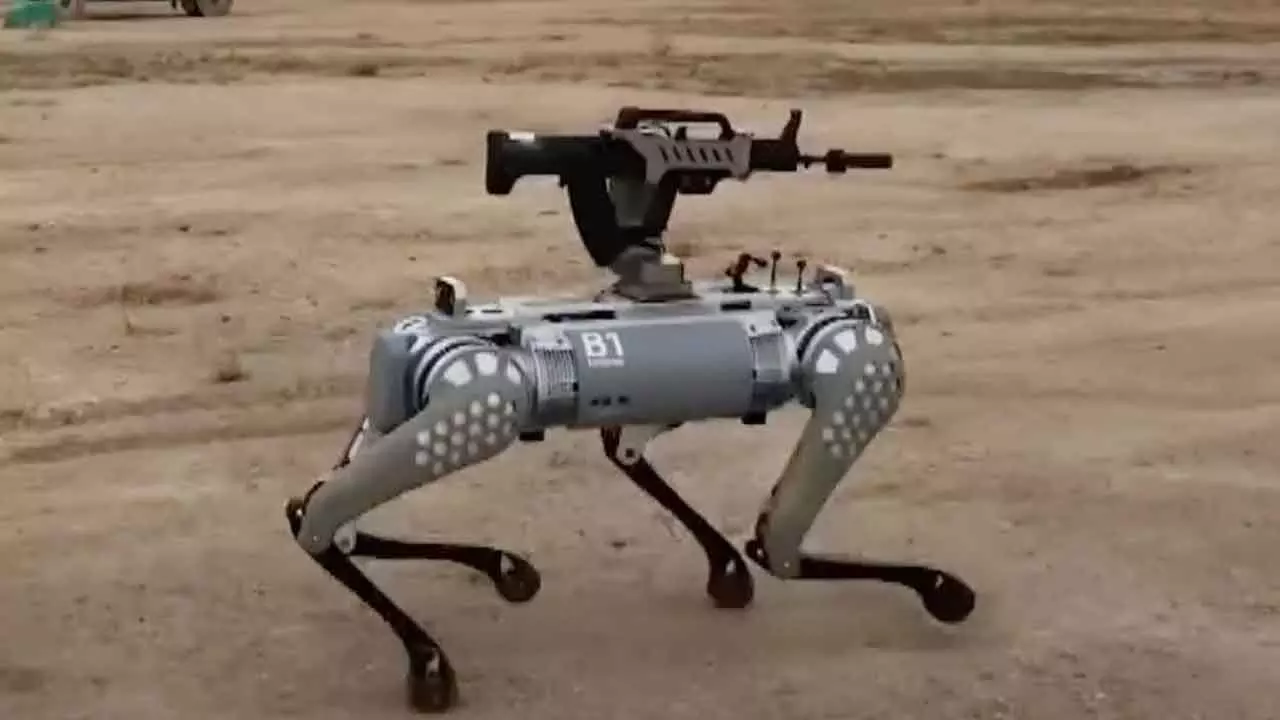Robotics Will Replace Human Soldiers In The Near Future
Ukraine was also the first military to form a standalone drone force – the Unmanned Systems Forces
Robotics Will Replace Human Soldiers In The Near Future

Autonomous systems are meant to perform dangerous tasks and reduce the risk to human personnel, making them ideal for warfare. The regulatory standards associated with ethical and legal concerns about autonomy, accountability, and the potential for escalating conflicts are the significant maintenance challenges.
Robotics is expected to play a crucial role in enhancing military capabilities and reducing risks to personnel, particularly in areas like logistics, surveillance, and reconnaissance this year.
Indian military is actively exploring and developing robotic systems, including humanoid robots for frontline missions. These advancements aim to improve operational efficiency, reduce troop exposure in high-risk environments, and provide a synergy between man and machine.
The global robotic warfare market size accounted for $31.66 billion in 2024 and is predicted to increase from $33.73 billion in 2025 to approximately $59.60 billion by 2034, expanding at a CAGR of 6.53 per cent from 2025 to 2034.
Demand for autonomous systems has increased in military operations, driving the growth of the robotic warfare market. The increased demand for advanced force protection and rapid support for complex scenarios are the major factors contributing to the market growth. The military robots market is set to grow into a $64 billion behemoth by 2034.
India is stepping into next-gen military technology with humanoid robot fighters, developed by DRDO for high-risk combat missions. With AI-driven decision-making, stealth mobility, and real-time threat detection, these robotic warriors aim to enhance battlefield efficiency and reduce troop casualties.
If all goes as planned, these humanoid soldiers could be commissioned by 2027, making India one of the first countries to integrate robotic fighters into its armed forces.
The United States is deploying its most advanced army of robots, marking a new era in military technology. Designed for reconnaissance, logistics, and even direct engagement, these robots enhance battlefield efficiency and reduce risks for human soldiers. Ukraine was also the first military to form a standalone drone force – the Unmanned Systems Forces.
“Ukraine is the world leader in robotics – not in sophistication, but in practicality,” said David Kirichenko, an expert in autonomous systems at the Henry Jackson Society, a UK think tank.
Ukraine’s 15,000 robots will be working alongside over 800,000 humans, and for the time being the machines will be in a supporting role rather than taking over combat.
“UGVs are likely to carve out an essential role in performing the most dangerous support tasks, where they can reduce risk to human soldiers without being lost in unsustainable numbers,” says Bondar.
The ratio of robots to humans may change rapidly in Ukraine as it has with drones. And over time AI in particular is likely to transform clumsy UGVs into more mobile, efficient fighting machines. It may not be happening yet, but removing humans from the front lines may be simply a matter of time.
The implementation of artificial intelligence (AI) in robotic warfare is playing a transformative role in modern warfare to advance its capabilities.
AI integration enables improved precision, efficiency, and strategic capabilities. It provides rapid and accurate autonomous decision-making abilities. AI in robotic systems is to operate at rapid speed with greater accuracy and reduce the risk of complications.
Autonomous systems are meant to perform dangerous tasks and reduce the risk to human personnel, making them ideal for warfare. AI not only enables the development of novel technologies to enhance military capabilities but also enables the detection and quick response to cyber threats in real time and improves the security of robotic systems. The regulatory standards associated with ethical and legal concerns about autonomy, accountability, and the potential for escalating conflicts are the significant maintenance challenges. However, AI makes it easier to operate robotics along with complying with regulations.
Asia Pacific is projected to grow at a solid CAGR in the robotic warfare market over the coming years. The growth is majorly driven by increased investments in unmanned systems and AI-powered technologies. The adoption of robotic systems has witnessed growth in Asia Pacific due to factors like increased regional geopolitical tensions and modernisations of military forces.
China, India, Japan, and South Korea are leveraging regional market expansion with heavy investments in edge technologies, focusing on advancing defence capabilities, and responding to regional security challenges.
India is still the second largest country, leading the regional market due to countries' growing defence budgets and focus on the adoption of advanced technologies. India witnessed rapid investments in the development of emerging technologies to enhance its military capabilities. Furthermore, government initiatives and regulatory support for the development of cutting-edge technologies are making essential impacts on the Indian robotic warfare area.
The ‘Make in India’ initiatives play a vital role in empowering key vendors to develop, manufacture, and assemble products in India, including automation and robotic warfare.

